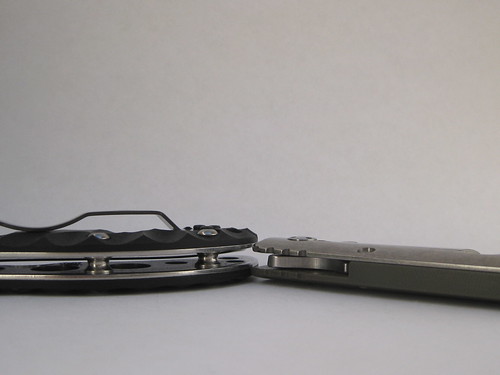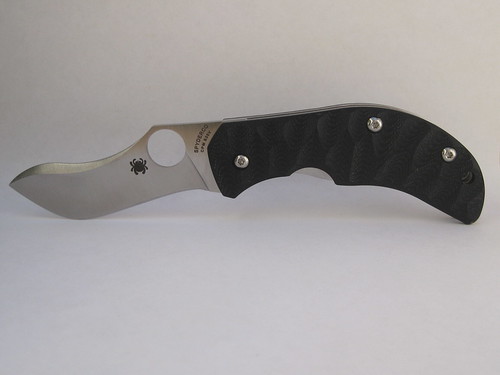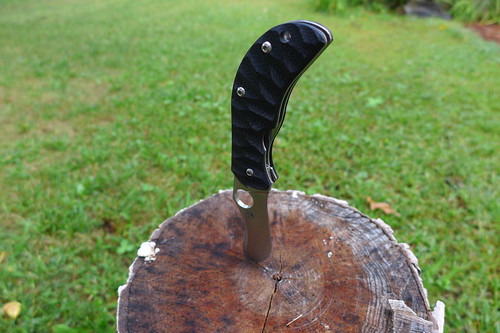Spyderco Zulu Review
Martin Heidegger, a complex and notorious philosopher from the early 20th century, had this idea that our approach to objects was characterized by two fundamentally different states of mind. The first state of mind he called present-at-hand. By that he meant that things were approached as if they were there solely for examination. A chemist, for example, looks at a molecules and how those molecules interact. For the chemist the molecules are present-at-hand, an object to conceptualize and study. Compare this to one's approach to objects that are ready-to-hand: a hammer is not generally something studied, but something that a person picks up and uses. It is a tool and we think about it only to the extent necessary to use it, especially if it is a well designed and well made hammer, one that works exactly as intended. For person using the hammer, the hammer is completely untheoretical. There is nothing contemplative to the person's approach to a hammer, they simply use it.
Imagine now that you were to redesign a knife (whew...you made it through that intro...thanks for hanging in there). Not just redesign A knife, but redesign KNIFE, the essential, ideal knife. What would it look like? Would it end up being similar to what we have? Would it be more like the crude stone tools of eons past (which look a lot like an ulu, if you are wondering)? What would that redesigned knife look like if it were designed entirely from as used perspective? What if the knife were not designed theoretically, with a concern for pivots and production costs, but instead designed experientially? What if you designed a folding knife entirely from the ready-to-hand perspective (noting, of course, the clash of designing and thinking about something conceptually and as it is used)?
That thought experiment is really interesting. One answer, I think, would be that you'd come up with something like the Spyderco Zulu. It is a strange, almost alien looking knife. It is wide and fat in places knives are usually skinny, and almost spindly in places where most knives are broad. The handles are finished in an unconventional way. The blade shape is bizarre. It looks a little like one of Darwin's finches--evolved and warped over time by use. But the genius of the Zulu is that it was not evolved over millions of years, but in the mind of Jens Anso (pronounced "Yens An SUE"), probably one of the ten most original knife makers in the world (I'd put him higher, but that is another fight for another day).
Something this different is very hard to evaluate. Playing with it and handling it helps. Opening it, carrying it, cleaning it and performing maintenance makes me more familiar with it, but this is not an object that can be understood purely theoretically. To get the Zulu, to truly understand it, you must use it and use it and use it. This is the ready-to-hand knife. And pulling apart that use-first design in a conceptual way like a review is very challenging. Describing what makes the knife a compelling design is much more difficult than using it and finding out that it is a compelling design.
Here is the product page. Here is a piece I wrote about it going out of production (though the knife is still widely available). It sells for about $100 street. Here is a written and video review by Andrew over at Edge Observer. Here is a video review by Cutlery Lover, who didn't love the Zulu. You can purchase the Zulu from Blade HQ and proceeds benefit the site and giveaways:
Blade HQ
Here is my video overview:
Finally, here is my review sample:
Blade HQ
Here is my video overview:
Finally, here is my review sample:
Twitter Review Summary: Listen to your hands, they'll tell you this is great. Ignore your eyes and brain, they'll be skeptical.
Design: 2
Evaluating something so different is a very slow and difficult process. Stravinsky's Rite of Spring was not well-received when it debuted. Now we recognize it to be a masterpiece. Similarly the Zulu is so different and so advanced, I fear that many just couldn't get over the fact that this little blade didn't look or feel like anything they had come to expect an knife to feel like. But weeks of intensive and almost exclusive carry convinced me that this is one hell of a design, perhaps the most refined knife design I have ever had the pleasure of using. This is advanced. There is no other way to say it. It makes other designs look downright Stone Age primitive. I'd give this knife's design a 4 if I could.
The ratios are weird because, well, the knife is weird. Here is the knife up against the good ole Zippo:
The blade:handle is .76, which is good, but does not fully capture the blade length given the curvy blade. The blade length measures 3.031 and the cutting edge measures 2.875 inches, but even that seems to miss the beauty of this blade. The blade:weight is .89, which is, again quite good. The knife just FEELS bigger than these two ratios would indicate, perhaps because of its unconventional shape and the places where it is bigger than other knives.
One more thing. Some folks are concerned that this is the thick knife. Here it is stacked up against on of the slimmest and trimmest blades out there, a Strider PT CC:
It is thicker than the PT CC but nothing outrageous and certainly not as thick as a Zulu custom.
Fit and Finish: 2
The ratios are weird because, well, the knife is weird. Here is the knife up against the good ole Zippo:
The blade:handle is .76, which is good, but does not fully capture the blade length given the curvy blade. The blade length measures 3.031 and the cutting edge measures 2.875 inches, but even that seems to miss the beauty of this blade. The blade:weight is .89, which is, again quite good. The knife just FEELS bigger than these two ratios would indicate, perhaps because of its unconventional shape and the places where it is bigger than other knives.
One more thing. Some folks are concerned that this is the thick knife. Here it is stacked up against on of the slimmest and trimmest blades out there, a Strider PT CC:
It is thicker than the PT CC but nothing outrageous and certainly not as thick as a Zulu custom.
Fit and Finish: 2
Taichung Taiwan makes the finest Spydercos. They are better than those made in Seki City, better than those made in China, and, well, as sad as it is to say it, better than those made in Golden Colorado for the most part. The Manix2 LW is a very well made knife, but I was stunned at how beautifully finished the Zulu was. The liner lock itself was a marvel, snicking into place with a quiet, subtle, unrocking strength. The Anso pattern was equally well attended to, with smooth corrugations that lock in the hand. And the jimping, oh wait, the knife's design makes jimping unnecessary. Another sign of the Zulu (and Anso's) brilliance.
Grip: 2
I alluded to this before, but, this is a knife that locks in to the hand. Here is a shot of me holding it:
Even the super grippy ZT350, the previous record holder for most grippy knife, pales in comparison. It comes down to the Zulu and the Brous Blade Silent Solider Flipper in terms of best grip in a production blade. The pistol grip is part of it, but the Anso pattern IS all it is cracked up to be. Even in wet conditions the Zulu never slipped out of my hand. The Zulu has persuaded me that jimping is a design crutch, an artificial way to improve the grip of knife when the design itself didn't take grip into account enough. Really go out and use the Zulu and you will see what I mean. A run of jimping, especially on the thumb ramp, would be easy enough to do, but on this knife it is entirely unnecessary.
Carry: 1
As I described it on GGL 16, the Zulu's handle, with its pistol grip, is a bit wide--it has some junk in the trunk. This is what I was referencing above when I wrote that the knife feels bigger than it measures. It can clog the opening of a pocket just a bit, not bad but worse than other knives.
Steel: 2
Both Spyderco and Chris Reeve leave their S30V softer than it could be, setting at around 58-60 HRc and the result is a knife that is much less chippy than one would think it would be knowing only the steel used. The S30V here is very good, holding an edge well, being durable in tougher and rougher cuts, and staying rust and color free through a series of messy cuts.
Testing the steel I ran through my expanded battery of test. I used it for EDC chores, such as opening package and cutting strings and the like, but I also did extensive food prep with this knife, cutting chicken, fruits, and veggies. My wife always rolls her eyes when I bust out a folding knife in the kitchen, but it is an excellent test of how the knife cuts and how corrosion resistant the steel is. Here the S30V killed it, resisting stains much better than the 8Cr13MoV from the Kershaw Injection 3.0. I also did some fire prep with the knife and it held up to the more demanding push cuts and whittling.
S30V may be more common nowadays but it is still a very good steel, especially when it is left a bit soft to compensate for its tendency to chip.
Blade Shape: 2
Not sure if you noticed this, but the Zulu has a pretty unconventional blade shape. Take a look:
There is a lot of belly, a ton really. But it is how all of this works together that is amazing. The front sharpened edge is excellent for kitchen cutting tasks. The Zulu sliced grapes and pepperoni better than any knife I have ever used, kitchen knife or otherwise. It just puts your hand and arm in such a natural place that cutting becomes effortless. This is the ready-to-hand aspect of the design. It works so well you don't even think about it.
But it does other things well too. With a lot of belly you can get good roll cuts and with a bit of a recurve and the spine shaped as it is you can choke up like crazy. There is virtually no EDC task that the Zulu didn't do incredibly well. This thing, because of the blade shape, cuts better than any knife I have used in normal use (as opposed to hard use) cutting tasks. This might be the zenith of cutting performance in EDC tasks.
Grind: 2
It is probably not feasible to replicate Anso's asymmetric grind in a production knife, but Taichung Taiwan did a great job of capturing all of the other complex lines from the Zulu custom. This fastidiousness results in amazing blade. The main grind is a high and very hollow grind making the Zulu an insane slicer. I am willing to concede that the unusual visuals on the grind might throw you off, but just try the Zulu. You'll like it. Also, it looks like a severe recurve, but in practice it is not. Here is a shot that shows you just how straight the knife really is:
Additionally, while the Zulu is probably all but impossible to sharpen on stones, if you have a rod sharpener like the Sharpmaker, it is not that bad. It is certainly a bit more complicated to sharpen than, say, my Dragonfly II, but it is not impossible. Thinking of it like a modified tanto and you'll do fine with any rod sharpener.
Deployment Method: 2
After two and half years it is odd that my first "real" Spyderco liner lock is the Zulu, but man is this a smooth knife. You can easily deploy it using the thumb hole without any wrist flick. The pivot is a good phosphor bronze number and the thumb hole is put in the exact right place. I really love the feel of flicking this knife open. Very high fidget factor.
Retention Method: 2
Spyderco's spoon clip is really underrated. It is very versatile, working on many different designs and here it works well. I especially like the subtle look of the black chromed finish. It both hides the knife and remains oddly scratch free for a good deal of time.
Lock: 2
The liner lock is not just smooth, it is rock solid. There is no play in any direction and the knife is easy to open and close. I think that the liner lock is wildly underrated and this knife shows why.
Overall Score: 19 of 20
The Zulu is not for everyone. There are mental hurdles to liking and appreciating this knife. But if you can put those aside for a month or so and use the Zulu you will love it. It does not look like a knife should look on a conceptual level, but in terms of use I have found nothing that is as pleasurable to use. Nothing. There are more aesthetically pleasing knives, lighter knives, and better finished knives (though not MUCH better finished knives), but no knife is better in use. This is a knife that is ready-to-hand. You do not think about the knife, you think about cutting. The knife becomes transparent and you simply cut as you think you should be able to without care or concern for the tool. It does not force you to work in a certain way, it simply meets your hand where your brain thinks your hand should be when you go about the task of separating one thing from another.
This is the rare and perhaps singular Spyderco where the parts and design features that are the essence of the Spyderco brand are not the most innovative part of the blade. Anso crushed it with the Zulu. It is a knife design that operates on a whole different level. To truly appreciate its genius you have to take an almost philosophical approach to the tool and its purpose. Hence the Heidegger. And sorry about that.
The Zulu is one hell of a blade and worth every penny.







